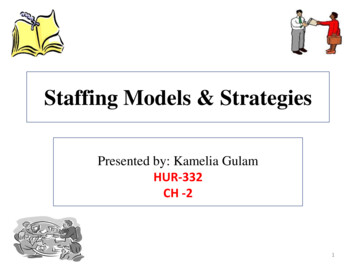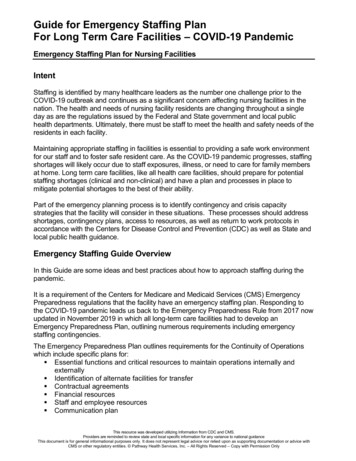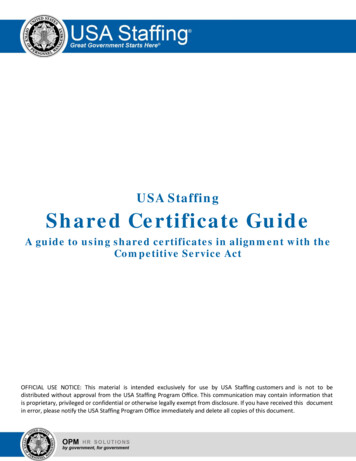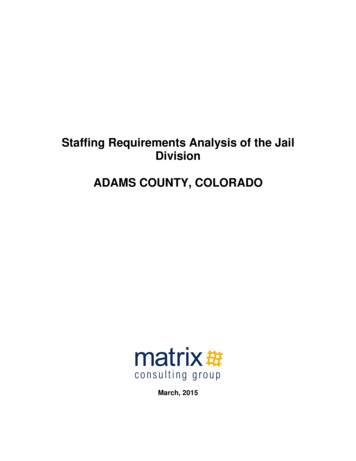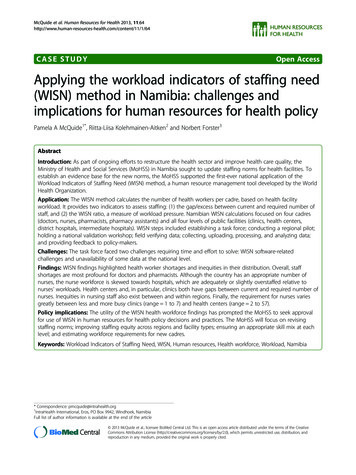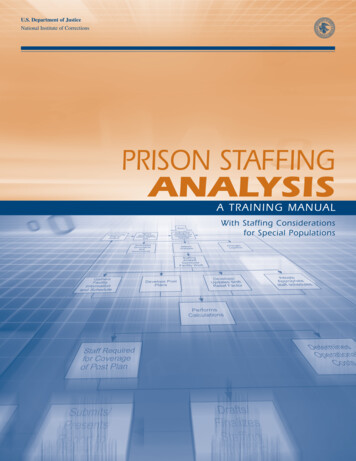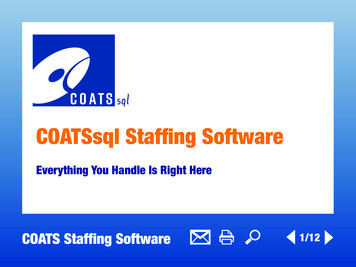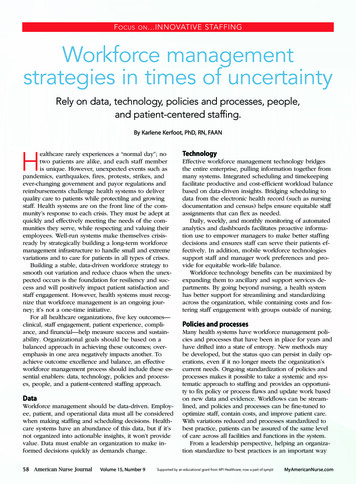
Transcription
STRICTLY CLINICALF OCUSON .INNOVATIVESTAFFINGWorkforce managementstrategies in times of uncertaintyRely on data, technology, policies and processes, people,and patient-centered staffing.By Karlene Kerfoot, PhD, RN, FAANHealthcare rarely experiences a “normal day”; notwo patients are alike, and each staff memberis unique. However, unexpected events such aspandemics, earthquakes, fires, protests, strikes, andever-changing government and payor regulations andreimbursements challenge health systems to deliverquality care to patients while protectilng and growingstaff. Health systems are on the front line of the community’s response to each crisis. They must be adept atquickly and effectively meeting the needs of the communities they serve, while respecting and valuing theiremployees. Well-run systems make themselves crisisready by strategically building a long-term workforcemanagement infrastructure to handle small and extremevariations and to care for patients in all types of crises.Building a stable, data-driven workforce strategy tosmooth out variation and reduce chaos when the unexpected occurs is the foundation for resiliency and success and will positively impact patient satisfaction andstaff engagement. However, health systems must recognize that workforce management is an ongoing journey; it’s not a one-time initiative.For all healthcare organizations, five key outcomes—clinical, staff engagement, patient experience, compliance, and financial—help measure success and sustainability. Organizational goals should be based on abalanced approach in achieving these outcomes; overemphasis in one area negatively impacts another. Toachieve outcome excellence and balance, an effectiveworkforce management process should include these essential enablers: data, technology, policies and processes, people, and a patient-centered staffing approach.DataWorkforce management should be data-driven. Employee, patient, and operational data must all be consideredwhen making staffing and scheduling decisions. Healthcare systems have an abundance of this data, but if it’snot organized into actionable insights, it won’t providevalue. Data must enable an organization to make informed decisions quickly as demands change.58American Nurse JournalVolume 15, Number 9TechnologyEffective workforce management technology bridgesthe entire enterprise, pulling information together frommany systems. Integrated scheduling and timekeepingfacilitate productive and cost-efficient workload balancebased on data-driven insights. Bridging scheduling todata from the electronic health record (such as nursingdocumentation and census) helps ensure equitable staffassignments that can flex as needed.Daily, weekly, and monthly monitoring of automatedanalytics and dashboards facilitates proactive information use to empower managers to make better staffingdecisions and ensures staff can serve their patients effectively. In addition, mobile workforce technologiessupport staff and manager work preferences and provide for equitable work–life balance.Workforce technology benefits can be maximized byexpanding them to ancillary and support services departments. By going beyond nursing, a health systemhas better support for streamlining and standardizingacross the organization, while containing costs and fostering staff engagement with groups outside of nursing.Policies and processesMany health systems have workforce management policies and processes that have been in place for years andhave drifted into a state of entropy. New methods maybe developed, but the status quo can persist in daily operations, even if it no longer meets the organization’scurrent needs. Ongoing standardization of policies andprocesses makes it possible to take a systemic and systematic approach to staffing and provides an opportunity to fix policy or process flaws and update work basedon new data and evidence. Workflows can be streamlined, and policies and processes can be fine-tuned tooptimize staff, contain costs, and improve patient care.With variations reduced and processes standardized tobest practice, patients can be assured of the same levelof care across all facilities and functions in the system.From a leadership perspective, helping an organization standardize to best practices is an important waySupported by an educational grant from API Healthcare, now a part of symplrMyAmericanNurse.com
STRICTLY CLINICALF OCUSON .INNOVATIVEto attain better quality, productivity, and sustainabilitywhile minimizing silos. Standardized staffing policy,consistent job descriptions, and continuous cross-training empower staff to confidently provide care outsideof their home unit in times of crisis. In addition, withstandardized pay and scheduling policies, staff knowthat everyone is treated fairly and equitably.STAFFINGEnabling outcomesTo ensure balance in key outcomes, healthcare organizationsmust rely on essential enablers—data, technology, policies andprocesses, people, and a patient-centered staffing approach.PeopleEverything that happens in healthcare is for people, bypeople. Every person in a hospital or health system playsa role in achieving clinical and financial outcomes, andall staff impact the patient experience, the bottom line,and the success of the organization.Workforce management connects human resources,nursing, clinical education, payroll, information technology, finance, nursing informatics, and other clinical disciplines within healthcare organizations. Creating a multidisciplinary ecosystem with a shared oversight andgovernance structure that spans individual facilities andthe system can ensure collaboration. When transparencyexists and people are invited to participate in developingprocesses and finding solutions, more innovative alternatives emerge, resulting in greater support, utilization, andadoption of the workforce management system.Whether or not an organization experiences a crisis,a clear picture of the entire pool of available staff, theirqualifications, credentials, and skill sets—regardless oftheir home unit or facility—makes it possible to quicklyand accurately match caregivers with patients. An enterprise-wide approach, supported by full transparency,allows qualified caregivers to move from areas of lowneed to areas of high need, which is both cost-effectiveand patient-centered.Patient-centered staffing approachEach patient is unique and their needs may change during hospitalization, making staffing a complex process.However, that process can be simplified when data, effective technology, people, and processes are integrated. A patient-centered staffing approach delivers morethan an acuity or ratio-based approach; it enables healthcare systems to deliver excellent patient care in day-today and extreme situations.Crisis and opportunityThe workforce impacts everything that happens withinhealthcare organizations. Creating a stabilizing workforce management strategy is imperative in “normal”times and becomes mandatory when chaos strikes. Everycrisis gives us the opportunity to re-examine what we’redoing and to reframe our future. Unfortunately, “chasing the next shiny object” can replace strategically “looking around corners” to determine what the organizationneeds in the near and distant future.MyAmericanNurse.comDiana Berkland, PhD, RN, FAAN, vice president ofnursing and clinical services at Sanford Health, cautionsthat innovation should contribute to a positive workplace environment and make the work less complicated. Mary Beth Kingston, PhD, RN, NEA-BC, chiefnursing officer for Advocate Aurora Health, notes thatinnovations must focus on creating a safe clinical enterprise and evaluating performance based on a balanced set of metrics. Berkland, Kingston, and their colleagues share more of their perspectives in the twocase studies that follow this article.Crises ranging from natural disasters to changing government regulations to social unrest will continue to challenge health systems nationwide. Building organizationalresiliency through a strong workforce management strategy is mission-critical. One of the most important lessonsof crisis readiness is recognizing that best practices arebuilt before the crisis and evaluated after to create newand more efficient practices for the future.ANKarlene Kerfoot is the chief nursing officer at API Healthcare and for its parentcompany, symplr, in Houston, Texas.ReferencesAshe L. The importance of adequate staffing. Nurs Manage. 2018;49(12):7.Paulsen RA. Taking nurse staffing research to the unit level. NursManage. 2018;49(7):42-8.Shin S, Park JH, Bae SH. Nurse staffing and nurse outcomes: A systematic review and meta-analysis. Nurs Outlook. 2018;66(3):273-82.September 2020American Nurse Journal59
STRICTLY CLINICALF OCUSON .INNOVATIVESTAFFINGA workforce managementstrategy that buildsorganizational resiliencyTechnology used wisely can help balance staff and patient needs.By Diana Berkland, PhD, RN, FAAN, and Meghan Goldammer, JD, RNAsolid workforce management structure has beena stabilizing force at Sanford Health amid theuncertainty and chaos created by the COVID-19pandemic. The system, which consists of six large medical centers and 40 critical access hospitals, is locatedprimarily in South Dakota, North Dakota, and Minnesota. A merger in January 2019 with the EvangelicalGood Samaritan Society added 158 skilled nursing andrehab sites across 24 states, home health agencies, sen-ior housing, and home- and community-based services.The region served by Sanford Health is home toseveral meat-processing and packing plants and longterm care facilities where outbreaks occurred in theearly days of the pandemic. Although the numbers ofCOVID-19 cases have varied across Sanford Health,the system’s data, flexible staffing, enterprise work60American Nurse JournalVolume 15, Number 9force management, and technology infrastructure haveenabled a coordinated and strategic response.Workforce management success factorsFour workforce management factors contribute to building stability and resiliency and serving staff and patientneeds over time.1. Sanford Health firmly believes that resiliency startswith the care unit directors and managers. They’reviewed as the chief executive officers of their departments with fiduciary accountability and responsibility for maintaining the appropriate staff numbers and skill sets to serve patients.2. These unit leaders must be committed to cross-training staff so they can be flexible, confident, andcomfortable providing care on other units whenneeded.3. Central nurse resource pools at the local and regional levels provide flexibility with cross-trainedskills that go beyond an employee’s single specialty,whether they work in med-surg, women’s, children’s,or critical care units.4. The system-wide nurse resource pool provides aninternal travel agency for the organization, whichspans more than 400,000 square miles and can helplocal and regional central nurse resource poolswhen needed.Underpinning this workforce management infrastructure is a supportive environment that meets theneeds of staff in normal times and enhances theirability to perform in emergencies. As a result of actionable and visible data and a focus on staff wellbeing, the organization has experienced a 12% decreasein agency use and a 2% decrease in RN turnoverfrom 2019 to 2020. (See Using culture to cultivatecommitment.)The role of data and governanceWorkforce data are essential to operations. Using sysMyAmericanNurse.com
STRICTLY CLINICALF OCUSON .INNOVATIVESTAFFINGUsing culture to cultivate commitmentSanford Health’s mission is to improvethe human condition at every stage oflife through exceptional care, spiritualenrichment, innovation, and discovery. The system’s operational framework is centered on several core values, including calling, courage, family,community, service, resolve, and advancement.This nursing leadership philosophy—Humanbecoming Paradigm—isbased on the work of nurse theoristRosemarie Rizzo Parse, PhD, RN, FAAN.It creates a “more alike than different”culture that calls on leaders to: promote mutual respect and trustencourage collaborationwelcome diverse perspectivesfocus on quality of life from eachperson’s perspective.Listening with a “willingness to beinfluenced” helps new team membersfeel valued and appreciated when mergers and acquisitions occur.Leading with respectSanford Health nurse leaders believetheir success is largely related to operational implementation, adoption,change management, and change leadership within the work environment. Toachieve this, they must be committedplan, and giving everyone opportunities to grow. Providing positive coaching and extensive competency training,along with having crucial conversations, creates the stability needed toensure staff success in providing excellent patient care.to a clear vision, and they must supporttheir staff with reverence and respect.A guiding premise for the leadershipteam at Sanford Health is recognizingthat if the staff feels valued and supported in their work, the financial outcomes will follow.Enabling staff to achieve work-lifebalance is key to helping them feelappreciated. Unit managers and directors must be well versed in the workforce technology to enable consistentstaffing with minimal chaos. Callingstaff every afternoon to work withoutforesight is a failure of leadership thatmay compromise their well-being; it’sa form of leadership malpractice. Thestaffing and scheduling committee iscalled the “Work-Life Balance Committee” to emphasize its importance.Critical to that work-life balance iscreating a solid and detailed successiontem-wide workforce technology* provides informationto local managers and directors, resource pools, andexecutives to ensure leading practices are in placethroughout the organization.A holistic approach to workforce management requires that all disciplines (not just nursing) use thesame platform. Integrating information—such as predictive and descriptive analytics based on volume,turnover, length of stay, leaves of absence, and othermetrics—completes the holistic picture. We createddashboards in response to COVID-19 and the accompanying medication, medical supplies, and personalprotective equipment (PPE) supply chain challenges.This allowed us to be nimble and accurate with supply-and-demand calculations. These data were instrumental in allowing leaders to make data-driven decisions to ensure patient and staff safety.Workforce management governance is comprehensive and takes two forms: the system workforce governance structure and the nurse executive council.MyAmericanNurse.comProof of conceptProof of the positive impact of thisleadership philosophy can be seen instaff engagement and patient outcomes. One hospital within the system hassuccessfully achieved four Magnet designations and another hasachieved three.In organizations that receive Magnetdesignation, nursing staff engagement, as measured by the PracticeEnvironment Scale, indicates staffexperience at or above the mean forcomparable organizations.Nurse-sensitive indicator outcomedata indicate low numbers of falls,pressure injuries, central line infections, and catheter-associated urinary tract infections.Clinical comparative data indicate astatistically significant improvementin overall rankings in most domainsfor the past 18 months.System workforce governanceThe system workforce governance structure includes allstakeholders and content experts, such as payroll administrators, finance officers, nursing informatics staff, nursingofficers, and information technology staff. This group provides oversight and monitors the workforce managementsystem, ensures standardization of nomenclature and system technology, decides which disciplines and units willuse the system, and determines implementation timelines.The system workforce governance structure alsodecides the best use of workforce management technology and has oversight for ensuring one consistent,leading practice standard throughout the organization.Staffing and scheduling software is used in areas otherthan nursing, so everyone must be represented as thetechnology is designed and developed.Nurse executive councilThe nurse executive council’s respectful, appreciative,trustful model ensures that everyone has a voice andSeptember 2020American Nurse Journal61
STRICTLY CLINICALF OCUSON .INNOVATIVEconsensus is obtained. The council determines staffingstandards, skill sets, and hours per patient day acrossthe organization and aligns these standards within theworkforce management technology.Sanford Health currently has five workforce management optimization projects: predictive/prescriptivedata analytics (which includes several interactive calculators), staffing standards, governance, position controldata standardization, and workforce management technology. The goal is to create an environment in whichpeople can do the work they’re called to with the resources they need to accomplish it.Coming together during the pandemicIn early 2020, staff needed to feel valued, safe, andsupported as Sanford Health navigated the turbulentfirst weeks of the COVID-19 pandemic. Guidanceabout the virus changed frequently and required clear,concise communication and trusted leadership. Thiswas accomplished, in part, via existing modalities, including the nursing governance structure, the nursing senate, various nursing governance councils, dailysafety briefs, and short weekly surveys to all staff. Inaddition to these regular interactions, the enterpriseand regional incident command structure provideddaily standardized, succinct, and transparent communication (including vertical and horizontal communication from point-of-service staff through executive leadership) to ensure proper information flow.The organization quickly posted a Facts over Fearpage on the intranet, and daily Town Hall sessionswere recorded so all shifts could hear the most currentinformation from leaders. In addition, weekly Facebook Live sessions, hosted by leaders, were well attended by thousands of team members. Guiding thiswork was a philosophical belief that point-of-servicestaff needed to feel safe and secure while providingcare. To that end, a PPE and supply-chain dashboardwas created to allow leaders to make data-driven decisions based on supply and demand. (Learn moreabout how to support staff at myamericannurse.com/?p 68570.)The cross-training that’s been in place at SanfordHealth’s flagship hospital in Sioux Falls, SD, for 20years provided a foundation for ensuring staff training,education, and competency when caring for patientswith COVID-19. In addition, the system’s well-established local and enterprise float pools consist of staffwho are enthusiastic about floating and confident intheir skills.Early in the pandemic, when patient volume insome units (including ambulatory care) was low, Sanford Health used the time for training and advancingskills and competencies to ensure staff could confidently take on challenges and be even better prepared62American Nurse JournalVolume 15, Number 9STAFFINGfor the future. Expert nurses were paired with novicenurses as volume surge plans were implemented, andupskilled ambulatory nursing personnel were preparedto work with expert nurses to ensure enough skilledstaff would be available for the projected surge in patients with COVID-19.Concern about the financial impact of a disastertends to dominate in stressful times. Examining howdecisions about finance affect patients, caregivers,and the success of the organization is important. Sanford Health takes a balanced approach to measuresuccess, with a focus on clinical outcomes, financialmetrics, patient experience, and healthcare workerexperience.Innovations for the futureInnovation is important for healthcare systems, but itshould add to, rather than detract from, the workplaceenvironment. Innovations should be viewed throughthe eyes of the staff. For example, mobile workforcemanagement technologies are important because thisis how millennials operate and we need to work within that world. These technologies include applications that are available via mobile devices and functions such as work schedules, available shifts, and timecard corrections and approvals that can be completedremotely.Data analytics and artificial intelligence should beaimed at taking work out of the system and providingsupport for leaders and end users, not making workmore complicated. As innovation occurs, everyone onthe team should acquire the skills needed to ask theright questions and extract meaning from the data.Sanford Health has achieved consistency, excellence,and equilibrium amid many chaotic events. We’ve useda sophisticated workforce management system to synthesize technology and the work environment to balance staff and patient needs. Leaders are responsiblefor creating a workplace environment that engages competent staff who can provide excellent patient care.Thanks to a rich and robust professional nursing culture, clear vision, and solid succession planning, Sanford Health is nimble and well-positioned for futuretidal waves of change.AN*Workforce Management Solutions by API Healthcare, now apart of symplrDiana Berkland is vice president of nursing and clinical services and MeghanGoldammer is chief nursing officer at Sanford Health in Sioux Falls, SouthDakota.ReferenceParse RR. The Humanbecoming Paradigm: A TransformationalWorldview. Pittsburgh, PA: Discovery International Publication; 2014.MyAmericanNurse.com
STRICTLY CLINICALF OCUSON .INNOVATIVESTAFFINGLeveraging size while remainingnimble with a workforcemanagement strategyHaving a staffing vision promotes optimal response to patient surges.By Margaret Gavigan, MSN, MBA, RN, NEA-BC; Jane Dus, DNP, RN, NE-BC; and Mary Beth Kingston, PhD, RN, NEA-BCDeveloping a robust, flexible nursing workforce overthe past 6 years has positioned Advocate AuroraHealth (AAH) to proactively manage uncertainty inan ever-changing environment, particularly during theCOVID-19 pandemic. By improving staffing processes,the system’s leaders have developed workforce management strategies to respond to change and build powerfulorganizational resilience. These qualities, in turn, haveprovided a stable foundation throughout the crisis.AAH is one of the 10 largest not-for-profit integratedhealth systems in the United States, serving nearly 3million patients annually in Illinois and Wisconsin acrossmore than 500 sites. The system’s purpose is to “helppeople live well” during times of crisis and calm, fullyembracing a whole-person health focus and commitment. Leaders have leveraged the size of the systemwhile moving with speed and agility to navigate thechanges created by the pandemic.Workforce management: A foundation fororganizational resilienceImproving patient health, safety, and satisfaction whilealso improving team member satisfaction and ensuringan optimal work environment have been key AAH goals.To meet them, leaders have implemented best practices, developed a robust infrastructure, and identifiedtools to help plan and deploy clinical labor resourcesto best meet patient needs.One initiative is the Effective Staffing Vision, whichis driven by a commitment to get five key things right:the right nurse, at the right time, with the right competencies and credentials, at the right cost. Three criticalsuccess factors for achieving this are shared governance,metrics, and standardization. (See Ecosystems unite stakeholders in staffing decisions.)Responding to COVID-19With a strong workforce management strategy alreadyin place, AAH was positioned to quickly and effectiveMyAmericanNurse.comly respond to the COVID-19 pandemic. The creation ofa virtual system labor pool command center was a keyworkforce strategy. Co-led by the vice president for talent acquisition and nursing, the command center includes team members from human resources (HR), HRanalytics, ambulatory, and the system float pool, alongwith a project manager and the contingent labor director. Working closely with each site’s labor commandteam, the command center developed a 24/7 online process for sites to request and reassign staff. The systemcommand center team helps optimize the use of allavailable, qualified staff. Success strategies include: allowing team members to volunteer for reassignment hiring more than 100 zero-assigned nursing students;nurses; and respiratory therapy, environmental services, and hospitality staff (all managed through thesystem labor pool) to support site needs partnering with contingent labor companies to hireand onboard agency nurses leveraging the relaxation of licensing requirementsat the state level to send nurses between state lines reassigning more than 5,000 team members to newroles matching prior work experience with work-fromhome or furloughed team members to meet site needs conducting twice daily system calls to address immediate and anticipatory staffing needs redeploying team members with medical restrictionsto nonclinical areas, such as managing departmentof health data requests creating a database of all available team membersfor potential staffing support.This collaborative approach to meeting patient careneeds was highlighted in the system’s response to asurge in patients requiring extracorporeal membraneoxygenation (ECMO) at one of the hospital sites. Tosimultaneously support up to 30 patients on ECMO ata single facility, highly qualified staff from throughoutthe system stepped up to help, with some staff staySeptember 2020American Nurse Journal63
STRICTLY CLINICALF OCUSON .INNOVATIVESTAFFINGEcosystems unite stakeholders in staffing decisionsAdvocate Aurora Health (AAH) uses two key strategies to ensure effective staffing: ecosystems (multidisciplinary and interdisciplinary teams) and engaged frontline nursing teams. The ecosystems are used to create structure, change processes, develop soundstaffing plans, and track key metrics at the system and local site levels.To avoid silos, AAH has standardized staffing and scheduling practices across the system, creating consistent job descriptions forall flexible staff and staffing offices, and synchronizing scheduling time frames. Scheduling software* has been leveraged to implement optimal care models. In partnership with finance, nursing budgeting principles have been developed, and both site and system multidisciplinary teams have been formed. Development of nursing strategic staffing plans with input from frontline nursing staffDeployment of tactical strategiesEnsure safe and effective staffing plansOversight and attainment of performance metric targetsChange and transition management System-wide development ofbudget assumptions to reflectactual performance Align the budget to ensurematching clinical resources topatient demand Support the standard staffingconfiguration plans and facilitateeffective position approvalprocesses Change and transitionmanagement Provide analytics to maintainalignment Demonstrate agility if commoncause changes threatenecosystem Efficient and effective on-boarding Facilitate cross training of staffwhere appropriate Development and deployment ofa flexible staff orientation Transition management Demonstrate agility if commoncause changes threaten ecosystem Proactive and innovative recruitment forvacancies and flexible nursing workforce Align wage and salary practices that attractand retain nursing staff Support standard staffing and schedulingpractices with change and transitionmanagement practices and tools Develop infrastructure and processes tosupport a system implementation ofstandard staffing and scheduling practicesand processes Change and transition management Proactive planning and delivering onplanned enhancements to system staffingand scheduling software*Workforce Management Solutions by API Healthcare, now a part of symplring in local hotels during the surge.Shared governance and an infrastructure to supportcollaboration between the system and individual sitespaves the way for creating a multidisciplinary group toanticipate equipment, resources, and staff needed for patient surges. The system and site labor command centerteams met twice daily to respond to staffing demands; thesystem is now developing a standard approach to anynew surges based on lessons learned. A database of furloughed, newly hired, and volunteer staff is instrumentalin helping with reassignments, including new roles suchas visitor and staff screeners or site-based testers.Ensuring nurses have the support they need for reassignments is a priority. The system-based nursing education and professional development team provide supportfrom the system and site perspective. From the system,64American Nurse JournalVolume 15, Number 9the team developed a virtual surge orientation staffing andcritical care program that focuses on helping furloughednurses from the OR, post-anesthesia care unit, and clinicsreturn to the med-surg unit or ICU bedside for clinical reassignment. Over 3,500 nurses participated in these onlineprograms. The nursing department also moved the orientation and new graduate residency program to a virtualformat for more than 3,000 nurses. The system team created COVID-19 educational videos, which have beenviewed over 37,000 times, and regularly updates personalprotective equipment (PPE) guides, which have beendownloaded 35,000 times.The site-based teams help share new daily information and updates, provide support for proper PPE donning and doffing, and, in many cases, provide directcare staffing or are reassigned to areas of high needMyAmericanNurse.com
STRICTLY CLINICALF OCUSON .INNOVATIVEsuch as employee health. An educational program supports implementing a team-based nursing model andhelps reassigned nursing education and professional development staff feel comfortable in their new roles. Inpartnership with nursing practice, these staff have implemen
es, people, and a patient-centered staffing approach. Data Workforce management should be data-driven. Employ-ee, patient, and operational data must all be considered when making staffing and scheduling decisions. Health-care systems have an abundance of this data, but if it's not organized into actionable insights, it won't provide value.
